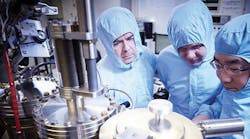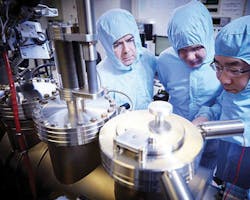This file type includes high-resolution graphics and schematics when applicable.
As “lower-frequency” applications, such as wireless communications, continue to consume bandwidth, researchers of imaging systems look beyond even the millimeter-wave range for available spectrum. For many applications, including materials research, medical diagnostics, and homeland-security systems, terahertz (THz) technology offers great promise. Located in that mysterious part of the electromagnetic (EM) spectrum where millimeter-wave EM energy makes the transition to infrared (IR) optical energy, THz imaging can provide greater focus and control than x-ray radiation.
Known as the “THz gap,” this band of the EM spectrum between about 300 and 3000 GHz (0.3 to 3 THz) contains signal wavelengths that are particularly useful for detecting dielectric differences in materials. It can be applied to a wide range of applications, from early detection of tooth decay to detection of hidden weapons and explosives. THz technology may even support high-data-rate, short-range wireless communications one day (see “Is Terahertz Li-Fi in Your Future?"). One key to realizing this promise will be the practical fabrication of semiconductor devices that can generate energy at THz frequencies.
Much research has been conducted on this portion of the EM spectrum due to the versatility of these small-wavelength electro-optical signals for material analysis and medical diagnostic applications, including for early detection of cancer (Fig. 1). A great deal of progress has been made in the development of passive components, such as antennas, needed for THz systems through the application of microelectromechanical-systems (MEMS) technology and small-wavelength circuit transmission-line techniques like substrate-integrated-waveguide (SIW) technology.
THz Research
Still, lots of work must be done in the areas of generating and detecting electro-optical THz energy. The trend of decreasing power with increasing frequency that’s common to the millimeter-wave EM portion of the frequency spectrum continues into the THz range, with signal power hard to come by at THz frequencies.
Organizations such as the University of Leeds (Leeds, UK) and the Rensselaer Polytechnic Institute (Troy, N.Y.) and its RPI Center for THz Research have devoted much effort to the study of THz technologies and the development of practical semiconductor solutions for the generation of THz energy. Device developers for THz frequencies typically look to high-speed switching semiconductors, such as Impatt diodes, based on semiconductor substrates long associated with high-frequency analog and high-speed digital circuitry, including gallium arsenide (GaAs) and indium phosphide (InP).
In contrast to X-rays, researchers at RPI, with numerous patents on THz generation and detection, refer to THz energy as T-rays. With funding from a diverse group of investors, including the National Science Foundation, the U.S. Army Research Laboratory (ARL), and the Defense Advanced Research Projects Agency (DARPA), RPI’s research focuses on generating, measuring, and recording THz waves.
THz signal generation has included exploration of plasma-wave excitation in submicron field-effect transistors (FETs), including those based on GaAs substrates. The goal is to allow the THz laboratory to develop tunable, solid-state THz devices that will make many of the potential applications for THz technology possible and practical.
Not Out of GaAs
Sources of THz energy are not plentiful, although some suppliers of millimeter-wave components and equipment also extend their engineering efforts into the THz range. They include Insight Product Co. with THz frequency synthesizers and TeraSense with Impatt-diode THz generators (Fig. 2). Although solid-state devices for generation of THz energy are limited in availability, a number of firms offer commercial THz-based test and diagnostic equipment.
For example, TeraView Ltd. developed three-dimensional (3D) THz-pulsed-imaging (TPI) technology that operates at room temperature. Products such as the firm’s TPS Spectra 3000 use high-speed lasers along with photoconductive semiconductor switches to generate and detect THz pulses without need of superconductors or cryogenic liquids to high-speed/high-frequency operation. A femtosecond laser operating at a wavelength of 800 nm and 100-fs pulse widths excites GaAs semiconductor substrate material to generate THz photon energy. Detection of the photon energy is performed by another GaAs semiconductor device excited by the same laser pulses.
Systems such as the TPS Spectra 3000 can measure the amplitude and phase of THz signals independently, to determine the absorption and refractive index of different materials in order to calculate the complex permittivity of those materials. This capability has clear benefits for materials analysis, such as analysis of semiconductor substrates and printed-circuit-board (PCB) laminates. However, it can also be used to find small defects in materials, like those mentioned earlier.
In addition, Advantest offers a number of THz imaging systems with coverage to 7 THz. The firm’s model TAS7400SU, for example, is a wideband system capable of operating from 0.5 to 7.0 THz. It generates and detects THz radiation, holding a sample for analysis within a sealed chamber. The system works with an external personal computer (PC) for control and data analysis. Two versions are available, each handling different operating temperature ranges (within the sample chamber): –10 to +80°C and +25 to +300°C.
Zomega Terahertz Corp. enters the fray with a number of THz-based diagnostic tools, including its compact Mini-Z time-domain spectrometer. The spectroscopic material measurement system is compact enough to be transported to any research or industrial site for nondestructive analysis of samples. It’s designed to fit within small equipment cases about the size of a notebook computer. The firm offers standard and high-speed models for different measurement requirements, bringing portability to high-precision THz analysis.
Many THz test and diagnostic systems employ discrete devices rather than ICs. Wider application of cost-effective THz technology will depend on the development of more integrated THz transceiver options. Use of nanoscale fabrication methodologies with existing semiconductor technologies, such as GaAs FET and silicon biCMOS processes, could help realize the small circuit dimensions required for THz wavelengths.
As this technology’s potential becomes more apparent for applications in the medical-diagnostics and materials-analysis fields, among others, demand will take off. Strong efforts from research organizations around the world will continue to improve integrated THz device solutions, creating a more practical technology that’s destined to become widespread.



